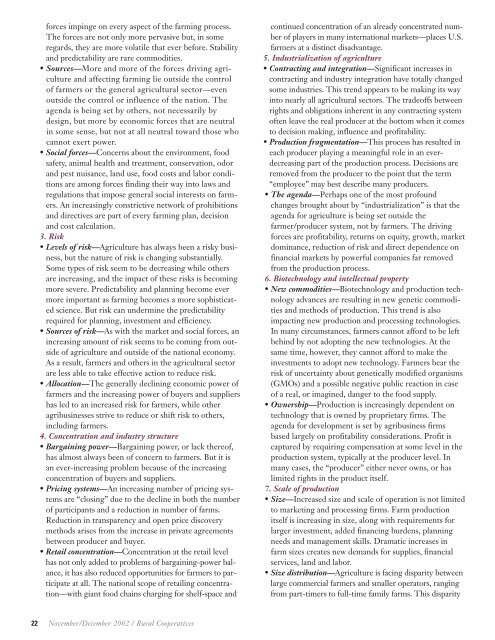1031924 Rur Coop-Nov/Dec 02 - USDA Rural Development - US ...
1031924 Rur Coop-Nov/Dec 02 - USDA Rural Development - US ...
1031924 Rur Coop-Nov/Dec 02 - USDA Rural Development - US ...
Create successful ePaper yourself
Turn your PDF publications into a flip-book with our unique Google optimized e-Paper software.
forces impinge on every aspect of the farming process.<br />
The forces are not only more pervasive but, in some<br />
regards, they are more volatile that ever before. Stability<br />
and predictability are rare commodities.<br />
• Sources—More and more of the forces driving agriculture<br />
and affecting farming lie outside the control<br />
of farmers or the general agricultural sector—even<br />
outside the control or influence of the nation. The<br />
agenda is being set by others, not necessarily by<br />
design, but more by economic forces that are neutral<br />
in some sense, but not at all neutral toward those who<br />
cannot exert power.<br />
• Social forces—Concerns about the environment, food<br />
safety, animal health and treatment, conservation, odor<br />
and pest nuisance, land use, food costs and labor conditions<br />
are among forces finding their way into laws and<br />
regulations that impose general social interests on farmers.<br />
An increasingly constrictive network of prohibitions<br />
and directives are part of every farming plan, decision<br />
and cost calculation.<br />
3. Risk<br />
• Levels of risk—Agriculture has always been a risky business,<br />
but the nature of risk is changing substantially.<br />
Some types of risk seem to be decreasing while others<br />
are increasing, and the impact of these risks is becoming<br />
more severe. Predictability and planning become ever<br />
more important as farming becomes a more sophisticated<br />
science. But risk can undermine the predictability<br />
required for planning, investment and efficiency.<br />
• Sources of risk—As with the market and social forces, an<br />
increasing amount of risk seems to be coming from outside<br />
of agriculture and outside of the national economy.<br />
As a result, farmers and others in the agricultural sector<br />
are less able to take effective action to reduce risk.<br />
• Allocation—The generally declining economic power of<br />
farmers and the increasing power of buyers and suppliers<br />
has led to an increased risk for farmers, while other<br />
agribusinesses strive to reduce or shift risk to others,<br />
including farmers.<br />
4. Concentration and industry structure<br />
• Bargaining power—Bargaining power, or lack thereof,<br />
has almost always been of concern to farmers. But it is<br />
an ever-increasing problem because of the increasing<br />
concentration of buyers and suppliers.<br />
• Pricing systems—An increasing number of pricing systems<br />
are “closing” due to the decline in both the number<br />
of participants and a reduction in number of farms.<br />
Reduction in transparency and open price discovery<br />
methods arises from the increase in private agreements<br />
between producer and buyer.<br />
• Retail concentration—Concentration at the retail level<br />
has not only added to problems of bargaining-power balance,<br />
it has also reduced opportunities for farmers to participate<br />
at all. The national scope of retailing concentration—with<br />
giant food chains charging for shelf-space and<br />
22 <strong>Nov</strong>ember/<strong>Dec</strong>ember 20<strong>02</strong> / <strong>Rur</strong>al <strong>Coop</strong>eratives<br />
continued concentration of an already concentrated number<br />
of players in many international markets—places U.S.<br />
farmers at a distinct disadvantage.<br />
5. Industrialization of agriculture<br />
• Contracting and integration—Significant increases in<br />
contracting and industry integration have totally changed<br />
some industries. This trend appears to be making its way<br />
into nearly all agricultural sectors. The tradeoffs between<br />
rights and obligations inherent in any contracting system<br />
often leave the real producer at the bottom when it comes<br />
to decision making, influence and profitability.<br />
• Production fragmentation—This process has resulted in<br />
each producer playing a meaningful role in an everdecreasing<br />
part of the production process. <strong>Dec</strong>isions are<br />
removed from the producer to the point that the term<br />
“employee” may best describe many producers.<br />
• The agenda—Perhaps one of the most profound<br />
changes brought about by “industrialization” is that the<br />
agenda for agriculture is being set outside the<br />
farmer/producer system, not by farmers. The driving<br />
forces are profitability, returns on equity, growth, market<br />
dominance, reduction of risk and direct dependence on<br />
financial markets by powerful companies far removed<br />
from the production process.<br />
6. Biotechnology and intellectual property<br />
• New commodities—Biotechnology and production technology<br />
advances are resulting in new genetic commodities<br />
and methods of production. This trend is also<br />
impacting new production and processing technologies.<br />
In many circumstances, farmers cannot afford to be left<br />
behind by not adopting the new technologies. At the<br />
same time, however, they cannot afford to make the<br />
investments to adopt new technology. Farmers bear the<br />
risk of uncertainty about genetically modified organisms<br />
(GMOs) and a possible negative public reaction in case<br />
of a real, or imagined, danger to the food supply.<br />
• Ownership—Production is increasingly dependent on<br />
technology that is owned by proprietary firms. The<br />
agenda for development is set by agribusiness firms<br />
based largely on profitability considerations. Profit is<br />
captured by requiring compensation at some level in the<br />
production system, typically at the producer level. In<br />
many cases, the “producer” either never owns, or has<br />
limited rights in the product itself.<br />
7. Scale of production<br />
• Size—Increased size and scale of operation is not limited<br />
to marketing and processing firms. Farm production<br />
itself is increasing in size, along with requirements for<br />
larger investment, added financing burdens, planning<br />
needs and management skills. Dramatic increases in<br />
farm sizes creates new demands for supplies, financial<br />
services, land and labor.<br />
• Size distribution—Agriculture is facing disparity between<br />
large commercial farmers and smaller operators, ranging<br />
from part-timers to full-time family farms. This disparity
















